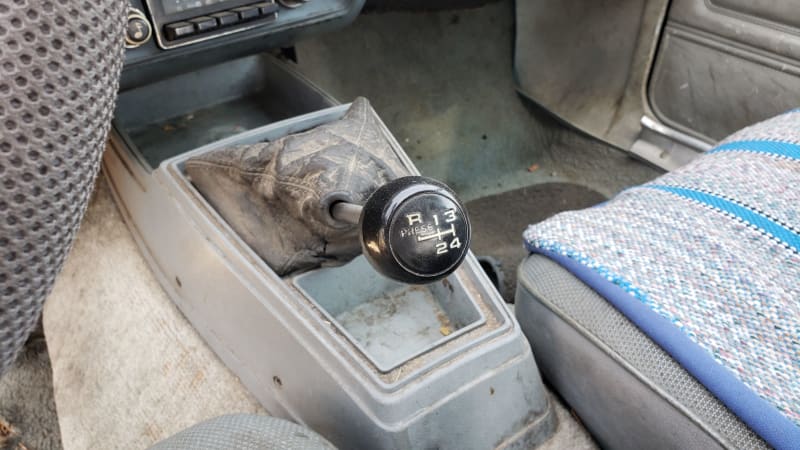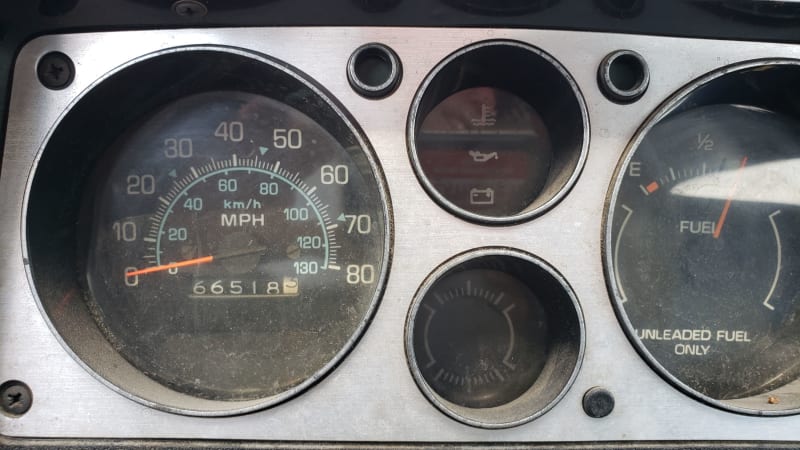General Motors developed the American-market Chevette in the immediate wake of the 1973 oil crisis, based on the “world car” rear-wheel-drive T-body design, and its low cost of manufacture and simplicity kept it in production here from 1975 all the way through the 1987 model year (for you trivia fans, the very first Chevettes were sold in Brazil in 1973). With versions sold by Isuzu, Vauxhall, Daewoo, Holden, and just about every outpost of the sprawling GM empire, a large percentage of the world’s population had the opportunity to drive these cars. Here’s a ’79 Chevette Hatchback Coupe, found covered with animal-rights and political bumper stickers in a Denver self-service car graveyard.
Yes, The General once used live animals for crash-safety testing, but a PETA campaign starting in 1991 resulted in the cessation of such testing by 1993. Here’s a bumper sticker from the “Heartbreak of America” ad campaign of that era, much faded after nearly 30 years in the Colorado sun. Did this Chevette’s owner buy a newer GM car after 1993, or was the Chevette good enough for the long haul?
These dashboard calendars seem to indicate that the car may have been parked for good after early 2004 (though some of the stickers on the hatch hail from many years later).
In addition to the pro-animal stickers all over the car, we find stickers from presidential campaigns starting with Dukakis-versus-Bush in 1988.
After being burned by support for Ralph Nader in 2000 (note the lack of Bush or Gore stickers from that year), the owner of this car appears to have opted to support both major candidates in the 2012 election. Strangely, the dog-on-the-roof incident didn’t seem to rule Romney out from this animal lover’s honor-roll hatch display.
Sold new in Englewood, will be crushed in the adjacent city of Denver.
Colorado and its dusty, windy, hail-prone climate are rough on windshields, so you don’t often see State Parks passes this old on cars these days.
In 1979, the Chevette had a 1.6-liter, Opel-designed four-cylinder engine rated at 70 horsepower. A couple of years later, North American Chevette buyers could get an Isuzu diesel engine (though very few did).
An automatic transmission was available, but it was a very expensive option relative to the cost of the car ($244 for a 3-speed automatic versus an MSRP of $3,098, or about $930 and $11,700 in 2020 dollars). Most Chevette buyers stuck with the base four-on-the-floor manual, and that’s what we have in today’s Junkyard Gem.
This factory-installed Delco AM radio and its single buzzy speaker cost 70 bucks extra, about $264 today after inflation.
I still find surprising numbers of Chevettes in junkyards, because so many were sold and their primitive technology enabled them to keep running for decades. The roomier and more efficient front-wheel-drive Pontiac (Daewoo) LeMans, Chevrolet (Suzuki) Sprint/Geo Metro, and Chevrolet (Toyota) Nova eventually resulted in the oft-delayed end of Chevette production.
Cheaper than Toyota, Datsun, and Volkswagen!
If you got the Chevette Hatchback Sedan instead of the coupe, you got the AM radio and other “pizza toppings” thrown in at no extra cost.
Drugs were strong in 1979.
Chevy salesmen had to sit through this training film in 1979.
The South Korean version was known as the Daewoo Maepsy, and sales benefited from futuristic TV commercials such as this one.










